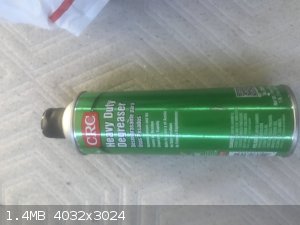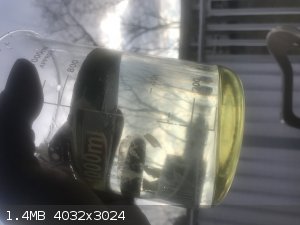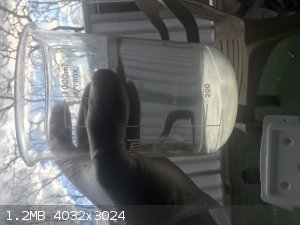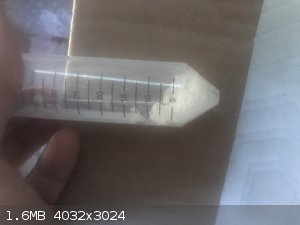erich_zurich
Harmless

Posts: 2
Registered: 16-4-2015
Member Is Offline
Mood: No Mood
|
|
chloral hydrate synthesis
Chloral hydrate synthesis from trichloroethylene. Every one is always talking about chloral hydrate from ethanol and chlorine gas, but I discovered a
way solely using household chemicals that doesn't involve nasty chlorine gas. Simple buy trichloroethylene brake pad cleaner and react it with
hypochlorous acid made from concentrated bleach and distilled vinegar, stir it occasionally and allow it to react for 2-3 days until the smell of
hypochlorous acid subsided. Collect the bottom organic layer of nonreacted trichloroethylene, this will contain dissolve choral hydrate in it, then
evaporate it with a hair dryer ect on a low heat setting. You will end up with a large amount of white crystals with a pungent odor reminiscent of
Chlorobutanol that melt easily. Reaction ingredients 60ml Trichloroethylene, 375ml 8.5% sodium hypochlorite solution, and 250ml distilled vinegar 5%
acidity. Choral Hydrate yield 25 grams.
|
|
|
Boffis
International Hazard
    
Posts: 1836
Registered: 1-5-2011
Member Is Offline
Mood: No Mood
|
|
If this works it would be a very useful reaction indeed as chloral hydrate is almost unobtainable these days and yet still a usefull organic
intermediate for the synthesis of substituted isatins. Do you have a reference for this reaction or did you discover it yourself? If the later do you
have some more data on the characterisation of the product other than "odor reminiscent of chlorbutanol" since I don´t know what chlorobutanol smells
like.
A few more details and some pictures would be nice too
My interest in this reaction is that I have done quite a few experiments on the oxidation of ethylene in an attempt to produce oxidative dimerisation.
There are two published procedures that I know of, one in Japanese which does not appear to be available digitally and one in from J Org Chem. Both of
these procedures use benzoyl peroxide to oxidize the trichloroethylene to a mixture of hexachlorobutene (main product C4H2Cl6), pentachlorobutadiene
(minor product C4HCl5) and traces of 1,2,3,4-tetrachloronaphthalene.
The alkaline nature of bleach could remove HCl from the trichloroethylene to yield 1,2-dichloroacetylene as described in one of Woelens threads and
then this could suffer chlorination by free chlorine produced by the break down of free hypochlorous acid as the mixture is acidified to give
tetrachloroethylene and finally hexachloroethane. As you can see there are many possible products of this reaction.
I have tried oxidizing trichloroethylene with sulphur at reflux temperatures but this reaction is very slow and almost all of the starting solvent was
recovered. with iodine and barium carbonate (the later compound to absorb the HI that might be produced before it could add across the ethylenic
bound. Curiously in this latter reaction I could find no evidence that the free iodine added to the double bond either, it seems remarkably
unreactive.
[Edited on 18-4-2015 by Boffis]
|
|
|
HgDinis25
Hazard to Others
  
Posts: 439
Registered: 14-3-2014
Location: Portugal
Member Is Offline
Mood: Who drank my mercury?
|
|
Please provide references. How did you find this out?
I can't think of way/mechanism for this reaction to work.
|
|
|
DraconicAcid
International Hazard
    
Posts: 4278
Registered: 1-2-2013
Location: The tiniest college campus ever....
Member Is Offline
Mood: Semi-victorious.
|
|
Addition of a halogen to and alkene in the presence of water can give a halohydrin. R2C=CR2 -> R2CClCR2OH With trichloroethene, this would give
1,1,1,2-tetrachoroethanol, with can hydrolyze to give chloral hydrate.
Please remember: "Filtrate" is not a verb.
Write up your lab reports the way your instructor wants them, not the way your ex-instructor wants them.
|
|
|
HgDinis25
Hazard to Others
  
Posts: 439
Registered: 14-3-2014
Location: Portugal
Member Is Offline
Mood: Who drank my mercury?
|
|
@DraconicAcid
That's a bit of a stretch. The formation of Halohydrins is usually done using bromine and is usually done using non-halogenated alkenes.
Trichloroethylene is fully chlorinated in one of its carbons.
And how can 1,1,1,2-tetrachoroethanol hydrolyze into Chloral Hydrate?
|
|
|
Boffis
International Hazard
    
Posts: 1836
Registered: 1-5-2011
Member Is Offline
Mood: No Mood
|
|
@HgDinis25
Actually DraconicAcids suggestion looks reasonable: HCl adds to trichloroethylene to give 1,1,1,2 tetrachloroethane so I can see how the addition of
hypochlorous acid HOCl could give rise to the analogous ethanol. The halogen and OH on the same carbón atom would shed HCl and then react with wáter
to give the hydrate.
I would still like to see a ref. but I´ll try this when I am home next. One observation thought is that chloral hydrate is soluble in wáter so I
would suggest adding salt to the aqueous phase and extracting with DCM or ether.
|
|
|
Polverone
Now celebrating 21 years of madness
        
Posts: 3186
Registered: 19-5-2002
Location: The Sunny Pacific Northwest
Member Is Offline
Mood: Waiting for spring
|
|
Transformation of trichloroethylene to chloral via hypochlorous acid appears to be patented, and the assignee is a chemical company with many other
patents. Not a lone inventor. This seems worth further investigation: https://www.google.com/patents/US2759978
PGP Key and corresponding e-mail address
|
|
|
Velzee
Hazard to Others
  
Posts: 379
Registered: 19-8-2015
Location: New York
Member Is Offline
Mood: Taking it easy
|
|
Synthesis of Chloral Hydrate
Since I needed chloral hydrate for a future synthesis, and I really didn't want to have to deal with large amounts of Cl2 gas, as well as seeing as
the previous user didn't seem to document their attempt, I decided to have a crack at this. So here is my short write up:
Firstly, I needed a source of trichloroethylene as it is a lot harder to find these days. I managed to find a source in a product called "CRC Heavy
Duty Degreaser" for about $20 USD, including shipping. MSDS states about 90% Trichloroethylene (and the rest, propellants), and each bottle contains
about a pound of product.
Using the flimsy straw that came with the can, I sprayed out and measured 87.6 grams of the trichloroethylene(TCE), which according to my math, is
60mL.
I then measured out the rest of the reactants, as according to @erich_zurich; 375mL of 8.5% NaClO solution(although mine is old so I expected it to be
less concentrated), as well as 250mL of 5% vinegar.
I then added the NaClO solution to a 1L beaker, followed by the TCE. Finally, the acetic acid went in, with no noticeable Cl2
release. The mixture was stirred by hand, rapidly to allow for good mixing. The beaker was then placed in a small cooler outside with the lid
slightly ajar to allow for any possible Cl2 released to escape.
After two hours, I went to stir the mixture, and to my surprise, the bottom TCE layer had taken up most of the yellow color of the solution, and a
very light underlying smell of chlorine could be detected.
I stirred the mixture occasionally throughout the next 48 hours, and on the second day, the mixture had gone nearly colorless, yet the smell of Cl2
remained.
On the third day, the solution remained the same color, but almost no Cl2 could be detected, and the mixture had taken up a medicinal smell, to my
hope.
I decanted the aqueous layer into a separate container, and collected the bottom layer in a separatory funnel. I set aside this layer in a beaker to
evaporate over a fan and an open window, while, thanks to a few who suggested this, I worked up the aqueous layer by adding 100mL of diethyl ether and
stirred vigorously, in order to try to extract any product that may be dissolved. I separated the ether as well and allowed that to evaporate, but to
no avail; almost nothing crystallized out of the solution.
After the TCE solution had all evaporated away, I was happily left with some white moist crystals left in the beaker, that smelled strongly medicinal.
I scraped these into a container and weighed the product.
I was left with 5.59g of chloral hydrate, which was much lower than I expected. Though, I am satisfied with this as it is enough to proceed with the
next steps in the synth.
I presume the reason for the low yield is possibly the older bleach, but mainly the fact that the product is extremely soluble in water, and
there's a LOT of water left over. I presume using newer bleach or calcium hypochlorite and glacial acetic acid would significantly increase the yield.
All in all, this is a much easier way of obtaining CH (besides locating a source of TCE) and a neat way at that.
[Edited on 1/23/2021 by Velzee]
   
[Edited on 1/24/2021 by Velzee]
Check out the ScienceMadness Wiki: http://www.sciencemadness.org/smwiki/index.php/Main_Page
"All truth passes through three stages. First, it is ridiculed. Second, it is violently opposed. Third, it is accepted as being self-evident."
—Arthur Schopenhauer
"¡Vivá Cristo Rey!"
—Saint José Sánchez del Río |
|
|
Tsjerk
International Hazard
    
Posts: 3022
Registered: 20-4-2005
Location: Netherlands
Member Is Offline
Mood: Mood
|
|
Nice! DDT for everyone!
Maybe you can saturate the water layer with salt before extracting?
|
|
|
Boffis
International Hazard
    
Posts: 1836
Registered: 1-5-2011
Member Is Offline
Mood: No Mood
|
|
Nice work Velzee! Good to see sometime else trying out some of the old claims.
Roughly how much of the TCE do you estimate had reacted? I am wondering if it would be possible to distill off some of the unreacted TCE and recycle
it into another batch and then work up the residue in order to improve the yield.
By the way please could you embed your images into the report so that they are always there. We have so many older threads on SM where the
illustrations are now just broken links.
|
|
|
Tsjerk
International Hazard
    
Posts: 3022
Registered: 20-4-2005
Location: Netherlands
Member Is Offline
Mood: Mood
|
|
Chloral forms a 7% azeotrope with water, so you could distill part of the water layer to concentrate the chloral.
https://en.wikipedia.org/wiki/Azeotrope_tables
[Edited on 24-1-2021 by Tsjerk]
|
|
|
njl
National Hazard
   
Posts: 609
Registered: 26-11-2019
Location: under the sycamore tree
Member Is Offline
Mood: ambivalent
|
|
Something you don't hear very often
|
|
|
Velzee
Hazard to Others
  
Posts: 379
Registered: 19-8-2015
Location: New York
Member Is Offline
Mood: Taking it easy
|
|
Quote: Originally posted by Boffis  | Nice work Velzee! Good to see sometime else trying out some of the old claims.
Roughly how much of the TCE do you estimate had reacted? I am wondering if it would be possible to distill off some of the unreacted TCE and recycle
it into another batch and then work up the residue in order to improve the yield.
By the way please could you embed your images into the report so that they are always there. We have so many older threads on SM where the
illustrations are now just broken links. |
Thank you! And it visually looked like only a bit of TCE actually reacted, maybe 10-15mL or so, but I didn't actually measure the volume. Distilling
may be a good idea, but I fear some product may carry over as well. And sure thing, I did so!
Check out the ScienceMadness Wiki: http://www.sciencemadness.org/smwiki/index.php/Main_Page
"All truth passes through three stages. First, it is ridiculed. Second, it is violently opposed. Third, it is accepted as being self-evident."
—Arthur Schopenhauer
"¡Vivá Cristo Rey!"
—Saint José Sánchez del Río |
|
|
Velzee
Hazard to Others
  
Posts: 379
Registered: 19-8-2015
Location: New York
Member Is Offline
Mood: Taking it easy
|
|
Ah, I didn't know that. Maybe I should do so when my glassware comes in.
Check out the ScienceMadness Wiki: http://www.sciencemadness.org/smwiki/index.php/Main_Page
"All truth passes through three stages. First, it is ridiculed. Second, it is violently opposed. Third, it is accepted as being self-evident."
—Arthur Schopenhauer
"¡Vivá Cristo Rey!"
—Saint José Sánchez del Río |
|
|
Tsjerk
International Hazard
    
Posts: 3022
Registered: 20-4-2005
Location: Netherlands
Member Is Offline
Mood: Mood
|
|
You could also make a fresh sodium hypochlorite solution with calcium hypochlorite and sodium carbonate, that way you can go much higher than 8.5%. In
the patent they talk about a 3 molar solution. You probably want to be able to do vacuum filtration though to filter the calcium carbonate.
http://www.sciencemadness.org/talk/viewthread.php?tid=156418
|
|
|
Velzee
Hazard to Others
  
Posts: 379
Registered: 19-8-2015
Location: New York
Member Is Offline
Mood: Taking it easy
|
|
Just got my glassware. Noticed that the azeotrope is actually 93% rather than 7%, maybe this still can be boiled? I still have the
solution left over.
Check out the ScienceMadness Wiki: http://www.sciencemadness.org/smwiki/index.php/Main_Page
"All truth passes through three stages. First, it is ridiculed. Second, it is violently opposed. Third, it is accepted as being self-evident."
—Arthur Schopenhauer
"¡Vivá Cristo Rey!"
—Saint José Sánchez del Río |
|
|
Tsjerk
International Hazard
    
Posts: 3022
Registered: 20-4-2005
Location: Netherlands
Member Is Offline
Mood: Mood
|
|
That is what I meant, you will get all chloral over in the first fraction boiling at 95 degrees. It will be a 7% solution of chloral in water.
|
|
|
stamasd
Hazard to Others
  
Posts: 133
Registered: 24-5-2018
Location: in the crosshairs
Member Is Offline
Mood: moody
|
|
The SDS for the CRC Heavy Duty Degreaser states that it contains 80-90% tetrachloroethylene, and 5-10% 1,2-dichloroethylene, not trichloroethylene. http://docs.crcindustries.com/msds/1003364E.pdf
I wonder how does the above work in light of this data.
All your acids are belong to us.
|
|
|
XeonTheMGPony
International Hazard
    
Posts: 1636
Registered: 5-1-2016
Member Is Offline
Mood: No Mood
|
|
I noticed that and used stronger amounts of bleach and vinegar, it is on the stirring plate and will let slow stir over night and then distill off and
see what I have, then re-run the chlorination step on the recovered organic layer
|
|
|
Tsjerk
International Hazard
    
Posts: 3022
Registered: 20-4-2005
Location: Netherlands
Member Is Offline
Mood: Mood
|
|
Trichlorethylen is being replaced by tetrachloroethylene, so they probably changed their formula.
[Edited on 12-2-2021 by Tsjerk]
|
|
|
stamasd
Hazard to Others
  
Posts: 133
Registered: 24-5-2018
Location: in the crosshairs
Member Is Offline
Mood: moody
|
|
Quote: Originally posted by Tsjerk  | Trichlorethylen is being replaced by tetrachloroethylene, so they probably changed their formula.
[Edited on 12-2-2021 by Tsjerk] |
Actually I'm pretty sure that this formula has been with tetrachloroethylene for quite a while, not a new change. If you look at the dates on the SDS,
the last revision was in 2017.
And given that tetrachloroethylene doesn't have any hydrogen bound to a carbon atom, I really don't see how an aldehyde group would be generated,
regardless of the amount of hypochlorite and vinegar used.
Cl2C=CCl2 ---?---> Cl3C-CH=O
Where would the H in -CH=O come from?
[Edited on 13-2-2021 by stamasd]
All your acids are belong to us.
|
|
|
Tsjerk
International Hazard
    
Posts: 3022
Registered: 20-4-2005
Location: Netherlands
Member Is Offline
Mood: Mood
|
|
Trichlorethylene is being replaced since around 2017 indeed, and no, tetrachloroethylene can't be used in this procedure. I assume Velzee used the old
stuff.
|
|
|
Texium
Administrator
       
Posts: 4508
Registered: 11-1-2014
Location: Salt Lake City
Member Is Offline
Mood: PhD candidate!
|
|
Well it would be good if Velzee could confirm this. It's possible that if it was tetrachloroethylene that he used, his solid product may actually be
hexachloroethane. It would be great to confirm the composition of the degreaser, and also to get a melting point of the solid product.
|
|
|